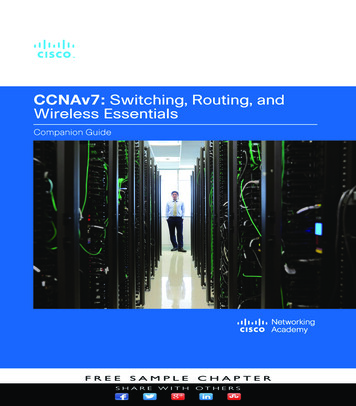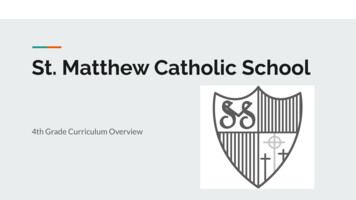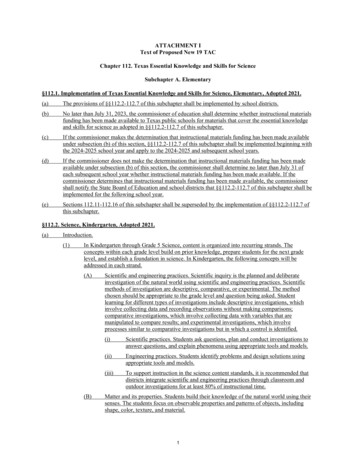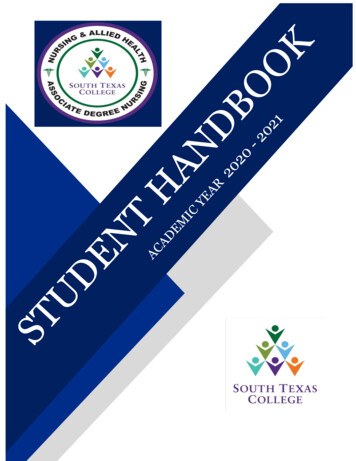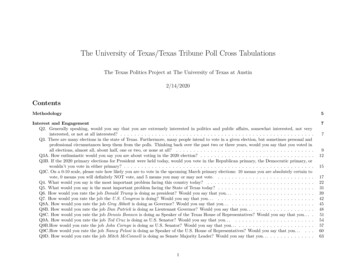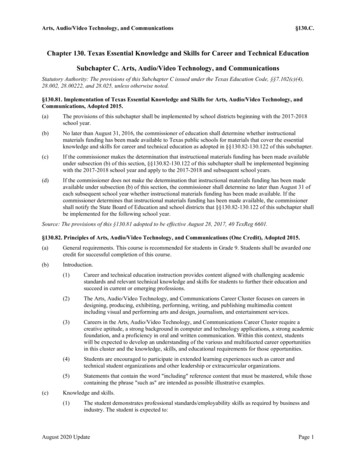
Transcription
Arts, Audio/Video Technology, and Communications§130.C.Chapter 130. Texas Essential Knowledge and Skills for Career and Technical EducationSubchapter C. Arts, Audio/Video Technology, and CommunicationsStatutory Authority: The provisions of this Subchapter C issued under the Texas Education Code, §§7.102(c)(4),28.002, 28.00222, and 28.025, unless otherwise noted.§130.81. Implementation of Texas Essential Knowledge and Skills for Arts, Audio/Video Technology, andCommunications, Adopted 2015.(a)The provisions of this subchapter shall be implemented by school districts beginning with the 2017-2018school year.(b)No later than August 31, 2016, the commissioner of education shall determine whether instructionalmaterials funding has been made available to Texas public schools for materials that cover the essentialknowledge and skills for career and technical education as adopted in §§130.82-130.122 of this subchapter.(c)If the commissioner makes the determination that instructional materials funding has been made availableunder subsection (b) of this section, §§130.82-130.122 of this subchapter shall be implemented beginningwith the 2017-2018 school year and apply to the 2017-2018 and subsequent school years.(d)If the commissioner does not make the determination that instructional materials funding has been madeavailable under subsection (b) of this section, the commissioner shall determine no later than August 31 ofeach subsequent school year whether instructional materials funding has been made available. If thecommissioner determines that instructional materials funding has been made available, the commissionershall notify the State Board of Education and school districts that §§130.82-130.122 of this subchapter shallbe implemented for the following school year.Source: The provisions of this §130.81 adopted to be effective August 28, 2017, 40 TexReg 6601.§130.82. Principles of Arts, Audio/Video Technology, and Communications (One Credit), Adopted 2015.(a)General requirements. This course is recommended for students in Grade 9. Students shall be awarded onecredit for successful completion of this course.(b)Introduction.(c)(1)Career and technical education instruction provides content aligned with challenging academicstandards and relevant technical knowledge and skills for students to further their education andsucceed in current or emerging professions.(2)The Arts, Audio/Video Technology, and Communications Career Cluster focuses on careers indesigning, producing, exhibiting, performing, writing, and publishing multimedia contentincluding visual and performing arts and design, journalism, and entertainment services.(3)Careers in the Arts, Audio/Video Technology, and Communications Career Cluster require acreative aptitude, a strong background in computer and technology applications, a strong academicfoundation, and a proficiency in oral and written communication. Within this context, studentswill be expected to develop an understanding of the various and multifaceted career opportunitiesin this cluster and the knowledge, skills, and educational requirements for those opportunities.(4)Students are encouraged to participate in extended learning experiences such as career andtechnical student organizations and other leadership or extracurricular organizations.(5)Statements that contain the word "including" reference content that must be mastered, while thosecontaining the phrase "such as" are intended as possible illustrative examples.Knowledge and skills.(1)The student demonstrates professional standards/employability skills as required by business andindustry. The student is expected to:August 2020 UpdatePage 1
§130.C.Arts, Audio/Video Technology, and Communications(2)(3)(4)(5)(6)(A)explore opportunities in training, education, and certifications for employment;(B)demonstrate professional standards and personal qualities needed to be employable suchas oral and written communication, leadership, teamwork, appreciation for diversity,conflict management, customer service, work ethic, and adaptability;(C)demonstrate skills related to seeking and applying for employment;(D)create a resume and cover letter/letter of interest to document information such as workexperiences, licenses, certifications, and work samples; and(E)demonstrate skills in evaluating and comparing employment opportunities.The student applies English language arts in Arts, Audio/Video Technology, and Communicationsprojects. The student is expected to:(A)demonstrate use of content, technical concepts, and vocabulary;(B)use correct grammar, punctuation, and terminology to write and edit documents;(C)identify assumptions, purpose, and propaganda techniques;(D)compose and edit copy for a variety of written documents;(E)evaluate oral and written information; and(F)research topics for the preparation of oral and written communication.The student applies professional communications strategies. The student is expected to:(A)adapt language structure and style for audience, purpose, situation, and intent;(B)organize oral and written information;(C)interpret and communicate information, data, and observations;(D)deliver formal and informal presentations;(E)apply active listening skills to obtain and clarify information;(F)develop and interpret tables, charts, and figures to support written and oralcommunications;(G)listen to and speak with diverse individuals; and(H)exhibit public relations skills to increase internal and external customer/clientsatisfaction.The student understands and examines problem-solving methods. The student is expected to:(A)employ critical-thinking skills independently and in groups; and(B)employ interpersonal skills in groups to solve problems.The student uses technology applications when completing Arts, Audio/Video Technology, andCommunications projects and processes. The student is expected to:(A)use technology applications such as social media, email, Internet, writing and publishing,presentation, and spreadsheet or database applications for Arts, Audio/Video Technology,and Communications projects; and(B)use processes such as personal information management, file management, and filesharing.The student understands arts, audio/video technology, and communications systems. The studentis expected to:(A)Page 2describe the nature and types of businesses in arts, audio/video technology, andcommunications;August 2020 Update
Arts, Audio/Video Technology, and yze and summarize the history and evolution of the arts, audio/video technology, andcommunications fields of study;(C)analyze the arts, audio/video technology, and communications economic base; and(D)analyze and summarize evidence of interdependence between the technical and theartistic sides of arts, audio/video technology, and communications.The student understands principles of audio/video production. The student is expected to:(A)apply knowledge of audio and video script production;(B)discuss the impact of audio and video selection on human emotion;(C)demonstrate the use of audio and video for a three-screen environment, including cellphones, television monitors, and computer screens;(D)demonstrate various videography techniques, including picture composition, videocomposition, audio composition, editing, and delivery;(E)understand the differences between linear and nonlinear systems; and(F)demonstrate knowledge of control peripherals for capturing or ingesting media.The student understands principles of fashion design that impact consumer purchasing of fashionand apparel accessories. The student is expected to:(A)describe social, cultural, and life cycle influences;(B)explain how fashion trends are determined; and(C)analyze the influence of advertising on consumer apparel choices.The student understands principles of video game design. The student is expected to:(A)demonstrate knowledge and appropriate use of computer operating systems;(B)demonstrate appropriate use of hardware components, software programs, and storagedevices;(C)demonstrate knowledge of sound editing;(D)demonstrate knowledge of file formats and cross-platform compatibility;(E)acquire and exchange information in a variety of electronic file sharing formats; and(F)combine graphics, images, and sound.The student understands principles of graphic design and illustration. The student is expected to:(A)research the history of visual arts and design;(B)explain the evolution of art and design;(C)compare current visual arts technologies with historical technologies;(D)understand general characteristics in artwork from a variety of cultures; and(E)analyze and apply art elements and principles in photographic works, multimediaapplications, and digital and print media.The student understands principles of commercial photography. The student is expected to:(A)demonstrate knowledge of photographic composition and layout; and(B)evaluate photographs using principles of art, commercial photography standards, andcritical-thinking skills.The student understands principles, elements, and techniques of animation. The student isexpected to:August 2020 UpdatePage 3
§130.C.Arts, Audio/Video Technology, and Communications(13)(14)(15)(16)(17)(18)Page 4(A)describe and use audience identification, script writing, character design, storyboarding,and audio and delivery formats;(B)describe and use cell, stop motion, tweening, motion paths, masking, looping,scripting/programming, and interactivity;(C)describe lighting and camera shots; and(D)describe and use flip books, claymation, or cut-outs;The student understands principles of printing and imaging. The student is expected to:(A)identify processes required for the production of various printed products;(B)identify basic design elements such as text, graphics, and white space; and(C)demonstrate basic knowledge of color theory.The student applies safety regulations. The student is expected to:(A)implement personal and classroom safety rules and regulations; and(B)follow emergency procedures as needed.The student identifies and develops leadership characteristics. The student is expected to:(A)identify leadership characteristics; and(B)participate in student leadership and professional development activities.The student applies ethical decision making and understands and complies with laws regarding useof technology in arts, audio/video technology, and communications. The student is expected to:(A)demonstrate an understanding of ethical conduct related to interacting with others such asmaintaining client confidentiality and privacy of sensitive content and giving propercredit for ideas;(B)examine the First Amendment, Federal Communications Commission regulations,Freedom of Information Act, liability laws, and other regulations for compliance issues;(C)examine the liabilities, copyright laws, fair use, and duplication of materials associatedwith productions and performances;(D)analyze the impact of arts, audio/video technology, and communications industries onsociety;(E)demonstrate an understanding of proper digital etiquette, personal security guidelines, useof network resources, and the district's acceptable use policy for technology; and(F)identify and demonstrate positive personal qualities such as flexibility, open-mindedness,initiative, listening attentively to speakers, willingness to learn new knowledge and skills,and pride in quality work.The student understands communications strategies as they relate to arts, audio/video technology,and communications. The student is expected to:(A)adapt the language and design of a project for audience, purpose, situation, and intent;(B)organize oral, written, and graphic information into formal and informal projects;(C)interpret and communicate information for multiple audiences; and(D)collaborate to create original projects, including seeking and responding to advice fromothers such as peers or experts in the creation and evaluation process.The student uses a variety of strategies to plan, obtain, evaluate, and use valid information. Thestudent is expected to:August 2020 Update
Arts, Audio/Video Technology, and Communications(19)(20)(21)§130.C.(A)obtain print and digital information such as graphics, audio, and video from a variety ofresources while citing the sources;(B)evaluate information for accuracy and validity; and(C)present accurate information using techniques appropriate for the intended audience.The student applies technical skills for efficiency. The student is expected to:(A)employ planning and time-management skills to complete work tasks; and(B)use technology to enhance productivity.The student develops a basic understanding of arts, audio/video technology, and communications.The student is expected to:(A)research the scope of career opportunities;(B)develop an understanding of the elements and principles of art;(C)develop an understanding of the industry by explaining the history and evolution of thearts, audio/video technology, and communications career fields and defining and usingrelated terminology;(D)evaluate works of art using critical-thinking skills;(E)determine the use of art elements such as color, texture, form, line, and space; and(F)determine the use of principles of design such as continuity, pattern, rhythm, balance,proportion, and unity in products.The student makes informed judgments about product designs and the designs of others. Thestudent is expected to:(A)interpret, evaluate, and justify artistic decisions; and(B)select and analyze original product designs by peers and others to form preciseconclusions about formal qualities and historical and cultural contexts, intents, andmeanings.Source: The provisions of this §130.82 adopted to be effective August 28, 2017, 40 TexReg 6601.§130.83. Animation I (One Credit), Adopted 2015.(a)General requirements. This course is recommended for students in Grades 10-12. Recommendedprerequisite: Art I or Principles of Art, Audio/Video Technology, and Communications. Recommendedcorequisite: Animation I Lab. Students shall be awarded one credit for successful completion of this course.(b)Introduction.(1)Career and technical education instruction provides content aligned with challenging academicstandards and relevant technical knowledge and skills for students to further their education andsucceed in current or emerging professions.(2)The Arts, Audio/Video Technology, and Communications Career Cluster focuses on careers indesigning, producing, exhibiting, performing, writing, and publishing multimedia content,including visual and performing arts and design, journalism, and entertainment services.(3)Careers in animation span all aspects of motion graphics. Within this context, in addition todeveloping technical knowledge and skills needed for success in the Arts, Audio/VideoTechnology, and Communications Career Cluster, students will be expected to develop anunderstanding of the history and techniques of the animation industry.(4)Students are encouraged to participate in extended learning experiences such as career andtechnical student organizations and other leadership or extracurricular organizations.August 2020 UpdatePage 5
§130.C.Arts, Audio/Video Technology, and Communications(5)(c)Knowledge and skills.(1)(2)(3)(4)Page 6Statements that contain the word "including" reference content that must be mastered, while thosecontaining the phrase "such as" are intended as possible illustrative examples.The student demonstrates professional standards/employability skills as required by business andindustry. The student is expected to:(A)identify and participate in training, education, or certification for employment;(B)identify and demonstrate positive work behaviors and personal qualities needed to beemployable;(C)demonstrate skills related to seeking and applying for employment;(D)create a career portfolio to document information such as work experiences, licenses,certifications, and work samples;(E)demonstrate skills in evaluating and comparing employment opportunities; and(F)examine employment opportunities in entrepreneurship.The student applies academic knowledge and skills in animation projects. The student is expectedto:(A)apply English language arts knowledge by demonstrating skills such as correct use ofcontent, technical concepts, vocabulary, grammar, punctuation, and terminology to writeand edit a variety of documents; and(B)apply mathematics knowledge and skills such as using whole numbers, decimals,fractions, and knowledge of arithmetic operations.The student understands professional communications strategies. The student is expected to:(A)adapt language for audience, purpose, situation, and intent;(B)organize oral and written information;(C)interpret and communicate information;(D)deliver formal and informal presentations;(E)apply active listening skills;(F)listen to and speak with diverse individuals; and(G)exhibit public relations skills.The student understands and employs problem-solving methods and conflict-management skills.The student is expected to:(A)employ critical-thinking skills independently and in groups; and(B)employ interpersonal skills in groups to solve problems.(5)The student applies technology applications. The student is expected to use personal informationmanagement, email, Internet, writing and publishing, and presentation applications for animationprojects.(6)The student applies cyber safety procedures. The student is expected to implement personal andprofessional safety rules and regulations.(7)The student applies leadership characteristics to student leadership and professional developmentactivities. The student is expected to:(A)demonstrate leadership skills independently and in a group setting;(B)conduct and participate in groups; andAugust 2020 Update
Arts, Audio/Video Technology, and Communications(C)(8)§130.C.model mentoring skills.The student applies ethical decision making and understands and complies with laws regarding useof technology in animation. The student is expected to:(A)exhibit ethical conduct related to interacting with others such as maintaining clientconfidentiality and privacy of sensitive content and giving proper credit for ideas;(B)discuss and apply copyright laws;(C)model respect of intellectual property;(D)demonstrate proper etiquette and knowledge of acceptable use policies; and(E)analyze the impact of the animation industry on society.(9)The student applies technical skills for efficiency. The student is expected to employ planning andtime-management skills to complete work tasks.(10)The student develops an understanding of animation technology. The student is expected to:(11)(12)(13)(14)(15)(A)demonstrate appropriate use of hardware components, software programs, and storagedevices;(B)demonstrate knowledge of sound editing;(C)demonstrate knowledge of file formats and cross-platform compatibility; and(D)acquire and exchange information in a variety of electronic file sharing formats.The student evaluates visual information. The student is expected to:(A)recognize the use of principles and elements of design; and(B)recognize the use of typography.The student uses an appropriate design process to create and modify solutions to problems. Thestudent is expected to:(A)combine graphics, images, and sound;(B)apply principles of design;(C)develop and reference technical documentation; and(D)edit products.The student creates animation projects. The student is expected to:(A)use a variety of techniques and software programs; and(B)publish and deliver products using a variety of media.The student researches the history and evolution of animation. The student is expected to:(A)explain the history of animation;(B)describe how changing technology is affecting the industry;(C)analyze the use of symbols in the animation of diverse cultures;(D)compare current animation technologies with historical technologies;(E)compare various styles of animation; and(F)explore emerging and innovative animation technologies and software.The student understands and applies animation principles, elements, and techniques. The student isexpected to:August 2020 UpdatePage 7
§130.C.Arts, Audio/Video Technology, and Communications(16)(A)describe and use audience identification, script writing, character design, storyboarding,and audio and delivery formats;(B)describe and use cells, stop motion, tweening, motion paths, masking, looping,scripting/programming, and interactivity;(C)describe lighting and camera shots;(D)describe and use flip books, claymation, or cut-outs;(E)render; and(F)describe and use postproduction processes such as editing and creating titles, credits, andspecial effects.The student presents oral or written evaluations of animation projects. The student is expected to:(A)identify the intended audience;(B)describe aesthetics;(C)explain the storyline;(D)summarize subject matter; and(E)discuss the use of sound.Source: The provisions of this §130.83 adopted to be effective August 28, 2017, 40 TexReg 6601.§130.84. Animation I Lab (One Credit), Adopted 2015.(a)General requirements. This course is recommended for students in Grades 10-12. Recommendedprerequisite: Art I and Principles of Arts, Audio/Video Technology, and Communications. Corequisite:Animation I. This course must be taken concurrently with Animation I and may not be taken as a standalone course. Districts are encouraged to offer this lab in a consecutive block with Animation I to allowstudents sufficient time to master the content of both courses. Students shall be awarded one credit forsuccessful completion of this course.(b)Introduction.(c)(1)Career and technical education instruction provides content aligned with challenging academicstandards and relevant technical knowledge and skills for students to further their education andsucceed in current or emerging professions.(2)The Arts, Audio/Video Technology, and Communications Career Cluster focuses on careers indesigning, producing, exhibiting, performing, writing, and publishing multimedia content,including visual and performing arts and design, journalism, and entertainment services.(3)Careers in animation span all aspects of motion graphics. Within this context, in addition todeveloping technical knowledge and skills needed for success in the Arts, Audio/VideoTechnology, and Communications Career Cluster, students will be expected to develop anunderstanding of the history and techniques of the animation industry.(4)Students are encouraged to participate in extended learning experiences such as career andtechnical student organizations and other leadership or extracurricular organizations.(5)Statements that contain the word "including" reference content that must be mastered, while thosecontaining the phrase "such as" are intended as possible illustrative examples.Knowledge and skills.(1)The student demonstrates professional standards/employability skills as required by business andindustry. The student is expected to:(A)Page 8identify and participate in training, education, or certification for employment;August 2020 Update
Arts, Audio/Video Technology, and Communications(2)(3)(4)§130.C.(B)identify and demonstrate positive work behaviors and personal qualities needed to beemployable;(C)demonstrate skills related to seeking and applying for employment;(D)create a career portfolio to document information such as work experiences, licenses,certifications, and work samples;(E)demonstrate skills in evaluating and comparing employment opportunities; and(F)examine employment opportunities in entrepreneurship.The student applies academic knowledge and skills in animation projects. The student is expectedto:(A)apply English language arts knowledge by demonstrating skills such as correct use ofcontent, technical concepts, vocabulary, grammar, punctuation, and terminology to writeand edit a variety of documents; and(B)apply mathematics knowledge and skills such as using whole numbers, decimals, andfractions and knowledge of arithmetic operations.The student understands professional communications strategies. The student is expected to:(A)adapt language for audience, purpose, situation, and intent;(B)organize oral and written information;(C)interpret and communicate information;(D)deliver formal and informal presentations;(E)apply active listening skills;(F)listen to and speak with diverse individuals; and(G)exhibit public relations skills.The student understands and employs problem-solving methods and conflict-management skills.The student is expected to:(A)employ critical-thinking skills independently and in groups; and(B)employ interpersonal skills in groups to solve problems.(5)The student applies technology applications. The student is expected to use personal informationmanagement, email, Internet, writing and publishing, and presentation applications for animationprojects.(6)The student applies cyber safety procedures. The student is expected to implement personal andprofessional safety rules and regulations.(7)The student applies leadership characteristics to student leadership and professional developmentactivities. The student is expected to:(8)(A)demonstrate leadership skills independently and in a group setting;(B)conduct and participate in groups; and(C)model mentoring skills.The student applies ethical decision making and understands and complies with laws regarding useof technology in animation. The student is expected to:(A)demonstrate an understanding of ethical conduct related to interacting with others such asmaintaining client confidentiality and privacy of sensitive content and giving propercredit for ideas;(B)discuss and apply copyright laws;August 2020 UpdatePage 9
§130.C.Arts, Audio/Video Technology, and Communicationsmodel respect of intellectual property;(D)demonstrate proper etiquette and knowledge of acceptable use policies; and(E)analyze the impact of the animation industry on society.(9)The student applies technical skills for efficiency. The student is expected to employ planning andtime-management skills to complete work tasks.(10)The student develops an understanding of animation technology. The student is expected to:(11)(12)(13)(14)(15)Page 10(C)(A)demonstrate appropriate use of hardware components, software programs, and storagedevices;(B)demonstrate knowledge of sound editing;(C)demonstrate knowledge of file formats and cross-platform compatibility; and(D)acquire and exchange information in a variety of electronic file sharing formats.The student evaluates visual information. The student is expected to:(A)recognize the use of principles and elements of design; and(B)recognize the use of typography.The student uses an appropriate design process to create and modify solutions to problems. Thestudent is expected to:(A)combine graphics, images, and sound;(B)apply principles of design;(C)develop and reference technical documentation; and(D)edit products.The student creates animation projects. The student is expected to:(A)use a variety of techniques and software programs; and(B)publish and deliver the product using a variety of media.The student researches the history and evolution of animation. The student is expected to:(A)explain the history of animation;(B)describe how evolving technology is affecting the industry;(C)analyze the use of symbols in the animation of diverse cultures;(D)compare current animation technologies with historical technologies;(E)compare various styles of animation; and(F)explore emerging and innovative animation technologies and software.The student understands and applies animation principles, elements, and techniques. The student isexpected to:(A)describe and use audience identification, script writing, character design, storyboarding,and audio and delivery formats;(B)describe and use cells, stop motion, tweening, motion paths, masking, looping,scripting/programming, and interactivity;(C)describe lighting and camera shots;(D)describe and use flip books, claymation, or cut-outs;(E)render; andAugust 2020 Update
Arts, Audio/Video Technology, and Communications(F)(16)§130.C.describe and use postproduction processes such as editing and creating titles, credits, andspecial effects.The student presents oral or written evaluations of animation projects. The student is expected to:(A)identify the intended audience;(B)describe aesthetics;(C)explain the storyline;(D)summarize subject matter; and(E)discuss the use of sound.Source: The provisions of this §130.84 adopted to be effective August 28, 2017, 40 TexReg 6601.§130.85. Animation II (One Credit), Adopted 2015.(a)General requirements. This course is recommended for students in Grades 11 and 12. Prerequisite:Animation I. Recommended corequisite: Animation II Lab. Students shall be awarded one credit forsuccessful completion of this course.(b)Introduction.(c)(1)Career and technical education instruction provides content aligned with challenging academicstandards and relevant technical knowledge and skills for students to further their education andsucceed in current or emerging professions.(2)The Arts, Audio/Video Technology, and Communications Career Cluster focuses on careers indesigning, producing, exhibiting, performing, writing, and publishing multimedia content,including visual and performing arts and design, journalism, and entertainment services.(3)Careers in animation span all aspects of motion graphics. Within this context, in addition todeveloping advanced knowledge and skills needed for success in the Arts, Audio/VideoTechnology, and Communications Career Cluster, students will be expected to create two- andthree-dimensional animations. The instruction also assists students seeking careers in theanimation industry.(4)Students are encouraged to participate in extended learning experiences such as career andtechnical student organizations and other leadership or extracurricular organizations.(5)Statements that contain the word "including" ref
Subchapter C. Arts, Audio/Video Technology, and Communications . Statutory Authority: The provisions of this Subchapter C issued under the Texas Education Code, §§7.102(c)(4), 28.002, 28.00222, and 28.025, unless otherwise noted. §130.81. Implementation of Texas Essential Knowledge and Skil



